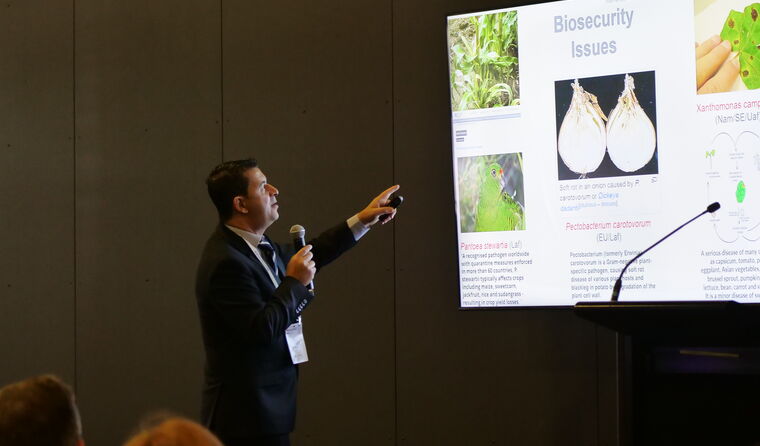News
‘Mobile petri dishes’: What bugs are lurking on GPs’ phones?
Did you take your phone to Sydney’s WONCA World Conference? Swabs taken at the event found doctors’ mobiles are a ‘breeding ground for contamination’.
 Associate Professor Lotti Tajouri presenting at the WONCA World Conference in Sydney last year.
Associate Professor Lotti Tajouri presenting at the WONCA World Conference in Sydney last year.
We take our phones everywhere – to work, in the car, running errands, and even to the toilet.
But a new study carried out at last year’s WONCA World Conference has revealed the concerning biohazard risks found on our mobile phones.
In newly published research, based on samples taken from 20 attendees’ mobile phones at the conference in Sydney in 2023, the plethora of pathogens that GPs could be exposing their patients to was revealed.
Researchers swabbed the 20 phones and found 2204 microbes on the devices, including 882 bacteria, 1229 viruses, 88 fungi, and five single-celled protists.
Bond University expert and Associate Professor of Genomics and Molecular Biology Lotti Tajouri has unveiled the scope of the concerning and disturbing bacteria breeding grounds we all carry around every day.
Associate Professor Tajouri told newsGP that not only were mobile phones a breeding ground for contamination, but they also have the potential to spread super bugs.
‘Antibiotic resistance genes were found at a very high amount,’ he said.
‘We found bugs that are not only big killers, but they have a strong amount of virulent factors for antibiotic resistance.’
The members whose phones were swabbed travelled far and wide to get to Sydney, including six from Europe, three from Central or South America, three from Northern Africa, and one from Southeast Asia.
With this in mind, Associate Professor Tajouri argues that GPs need to be more mindful around the sanitisation of their phones.
‘It doesn’t make sense that we have mobile phones in medical settings,’ he said.
‘It doesn’t make sense that conferences of medical staff come with their mobile phones from overseas and are not sanitising them or knowing that mobile phones are literally mobile petri dishes.’
Of those attendees surveyed, 98% used their phones for work and 99% at home, meaning contaminated phones are being transported between locations.
Additionally, 99% of respondents said they used their phones while travelling – bringing those bugs from one end of the globe to the other in a matter of hours.
While 94% of WONCA participants said they washed their hands at work and 97% washed their hands after using the toilet, more than half used phones in the toilet, and 71% used their phones while eating.
‘It is evident there is a need to sanitise hands, but also sanitise mobile phones to prevent phones from negating hand hygiene practices,’ Associate Professor Tajouri said.
‘We take our phones absolutely everywhere, we travel with our phone, and we spread microbes all over the world.
‘All your microbes, regardless of the pathogenic or not, can be opportunistic, infectious diseases for immunocompromised individuals.’
Research team member and Chair of RACGP Expert Committee – Quality Care Professor Mark Morgan told newsGP mobile phones could be a ‘weak link’ in the spread of disease around the globe.
‘I think there’s certainly a reason to investigate it further and considering having home sterilising units at borders and in healthcare facilities,’ he said.
‘If you do need to access the phone during work, then it would be worth doing some hygiene immediately afterwards.’
Professor Morgan said he was surprised at how good mobile phones were at harbouring deadly microbes.
‘You can imagine every door handle and every keyboard that’s handled frequently to be covered in bacteria and we know they are,’ he said.
‘But there are all the things that contribute to them being such an excellent place for microbes to live.
‘I was surprised by the extent of resistance factors that were found.’
Associate Professor Tajouri said for GPs especially, who see multiple patients each day, phone sanitation is crucial.
‘Immunocompromised individuals in GP practices might be exposed to some bugs because the GP has not been sanitising,’ he said.
But according to Associate Professor Tajouri there is a solution in the form of making phone sanitation as simple as hand washing.
At WONCA, he demonstrated this with a UV-V phone sanitiser called CleanPhone, used for global health and infection prevention and control.
This sanitiser was designed to be practical and automatic, meaning medical staff can wash their hands while also sanitising their phones at the same time.
Associate Professor Tajouri said he would also like to see these sanitation devices rolled out at airports across the world, as well as at conferences, such as WONCA, on cruise ships, and food halls.
‘Yes, you have mobile phones that are contaminated but yes, there is a solution to it,’ he said.
Log in below to join the conversation.
:mobile antibiotics antimicrobial resistance infection control microbes mobile phones phones research superbugs
newsGP weekly poll
Which of the following areas are you more likely to discuss during a routine consultation?